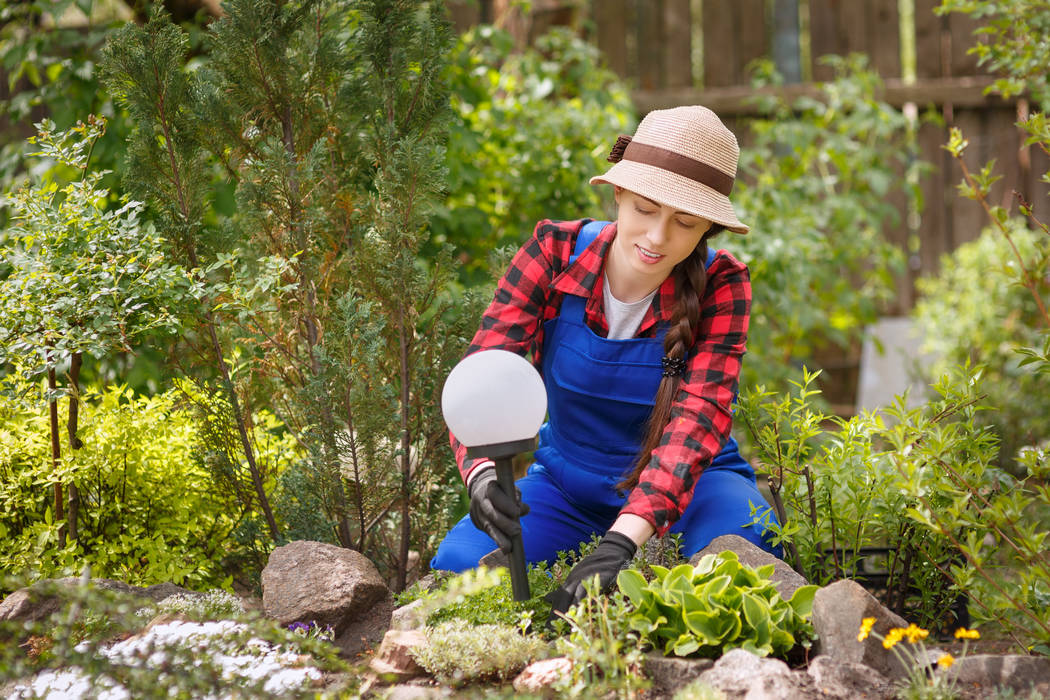Landscape lighting can be dramatic if done right
Q: A while back you wrote about how to repair a problem with landscape lights. My husband and I don’t have such a system yet, but we plan on buying one and would like to know how to install it.
A: Landscape lights can really dress up a yard unless, of course, you’re my neighbor. One of my neighbors has a fountain that they illuminate with a light that is brighter than the sun. I can’t look at the thing without burning my retinas. I think that people flying into the city at night can even see it.
Most landscape lighting, however, is subtle and can be very dramatic if done correctly.
Start by looking at what you want to achieve. Pick a few focal points you want to draw attention to and decide your course of action.
You can use uplighting, for example, at the base of a tree, where the light shines up the trunk and into the branches. Downlighting is hung from trees or structures and cast light to the ground. Path lighting uses taller fixtures to illuminate a walking path or garden area. You can also shine a spot fixture on an object.
The low-voltage systems you buy in home centers range from around $60 to $200. They are sold in kits that include the transformer, cable and lights. You can buy far more elaborate and expensive systems at specialty retailers.
Low-voltage systems reduce the household current down to 12 volts. The systems are safe and easy to install.
After you have mapped out the system, you have to find a power source for the transformer. The power source will usually be a ground-fault circuit-interrupter protected outlet. Install the transformer near the outlet and remove the cover that hides the terminals. Attach the cable to these terminals to supply power to the lights.
Roll out the cable to the areas you will illuminate.
Then the fun begins. Use a flat-nosed shovel and push it into the ground 6-8 inches and pry the ground open. This will create a V-shaped trench in which to bury the cable. Repeat this along the entire length of the cable and lay the cable next to the trench. Assemble the light fixtures (push the bulbs in and screw them together) and attach them to the cable.
The fixtures will have two small wires that attach to a cable connector. The cable connector makes contact with the cable and pierces it to contact the copper strands inside.
Your connector will come in two pieces. One side will have the sharp pins that pierce the cable, and the other will hold the connector to the cable. The connector pieces will either screw or slide together.
Once the connection is secure, push the stake into the ground at the proper height. Push the cable into the ground with a wooden paint stir stick.
When all the fixtures are installed, plug the transformer into the outlet and turn it on. The fixtures should all light up. If they don’t, the pins may not be contacting the cable properly. Push the connector in a little more or pull it out and reinstall it.
You can adjust the concentration of the light by turning the lens cap on the fixture to make the light more or less focused.
Cover up the cable and set the timer on the transformer.
You can add additional fixtures. Add up the wattage of all of the lamps, but they should not exceed the output of the transformer.
When you start adding fixtures, there are lots of rules to deal with regarding cable size and output, so check the manufacturer’s recommendations. If you stick with a home center kit, you should be fine. If you buy items a la carte, consult a professional. You could encounter “voltage drop” near the end of the run, which will make those fixtures at the end of the cable dim.
Mike Klimek is a licensed contractor and owner of Las Vegas Handyman. Questions may be sent by email to handymanoflasvegas@msn.com. Or mail to 4710 W. Dewey Drive, No. 100, Las Vegas, NV 89118. His web address is www.handymanoflasvegas.com.
Do-it-yourself
Project: Install landscape lighting
Cost: From around $60
Time: 4-8 hours
Difficulty: ★★★























